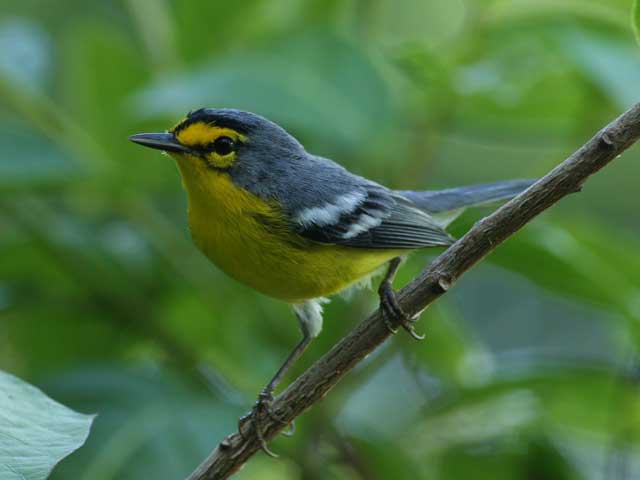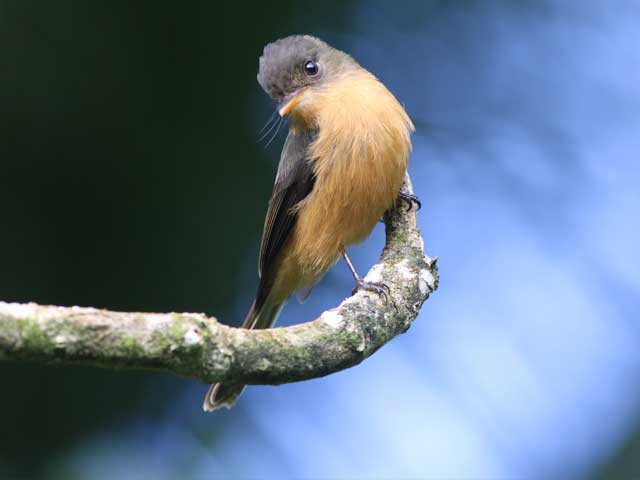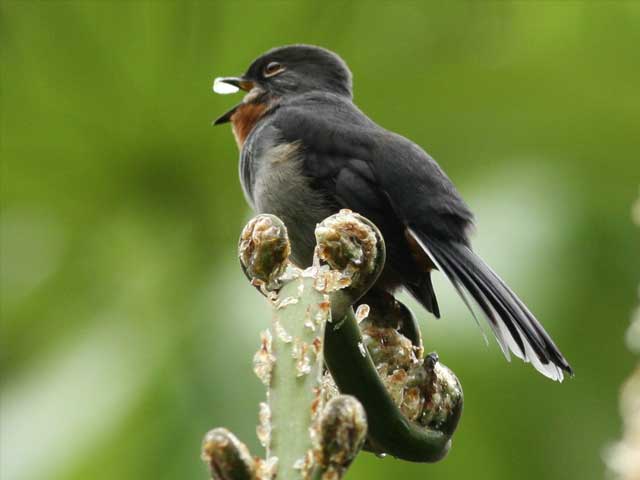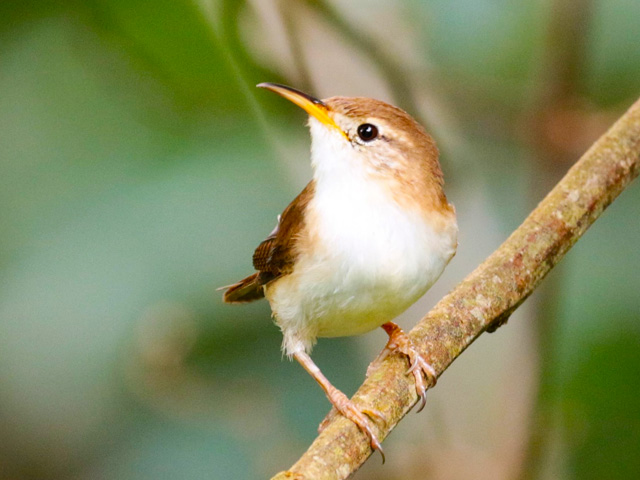- Details
- Category: About
INTRODUCTION TO SAINT LUCIA BIRDS
Saint Lucia is blessed with a bounty of indigenous fauna and flora. Our landscapes: hills, valleys, wetlands, dry lands and coat lines creates opportunities for bird species to thrive. St. Lucia houses approximately 176 bird species.
Endemic Birds of St. Lucia
Our national bird, the Saint Lucia Parrot (Amazona versicolor), unique only to Saint Lucia, represents our island nation and its spectacular natural beauty to the world. This bird may well stand for our nation’s resilience and ability to stand up against adversity having recovered from dangerously low population numbers in the early 1980’s. The Saint Lucia Parrot is not the only endemic bird to the island. To date, it is only one of six species that are identified as unique to Saint Lucia. The other endemics are the St. Lucia Pewee (Contopus oberi), St. Lucia Warbler (Dendroica delicate) St. Lucia Oriole (Icterus laudabilis), St. Lucia Black Finch (Melonospiza richardsoni), Semper’s Warbler (Leucopeza samperi).
This number already gives Saint Lucia the distinction of having the highest number of endemic birds amongst the islands of the Eastern Caribbean. There are yet other potential species which may one day join the ranks of birds recognized as distinctly Saint Lucian when the conservation biologists and geneticists turn their attention to them.
Regional Endemic Birds in St. Lucia Species
Saint Lucian avifauna also includes a number of regional endemics including our own race of the White breasted Thrasher, Rufous Nightjar and House Wren. These are our gems to treasure amongst approximately 50 resident species which are attractive to birdwatchers local and foreign alike.

Download our Bird Guide and Checklist of St. Lucia Birds
Migrant Birds Spices in St. Lucia
The migrant birds also constitute an enriching and yet transient element to Saint Lucia’s avifauna biodiversity. For the fortunate few who are aware of Saint Lucia’s “native” birds, the migratory birds add an interesting and somewhat mysterious element to our wildlife. Their stopover appearances around home gardens, shorelines or water treatment ponds during their southbound journeys from North America to the Caribbean and beyond has prompted the occasional curious phone call to the Forestry Department by individuals seeking to identify them.
Far from being considered a foreign element, such migratory birds should be regarded as an indigenous part of St. Lucia’s wildlife and appreciated as such. Very few Saint Lucians are aware of the swallows, sandpipers, warblers and the wild ducks that journey over thousands of miles from their summer breeding range to our shores to escape the cold northern winters.
Many strictly associate such birds with North America or Europe and yet our local names such as “canard sauvage” for the wild ducks, and the various “becassine” (sandpipers) seen along the beaches reflect our longstanding knowledge of these birds as part of our natural heritage. In the last century almost a hundred migratory species have been recorded in St. Lucia and therefore they constitute the majority of our avian diversity. Many of these birds are either fully protected or partially protected under the Wildlife Protection Act (1980).
Challenges
St. Lucia is no different from the rest of the region in its efforts at confronting the challenge of achieving sustainable development while securing its natural resources. However, sustainable development can only be achieved on the basis of informed decision making. Decision making under circumstances where there is a lack of data leads to an uninformed position and a lack of an awareness of possible options. This is particularly crucial to the decision making process relating to land use and land use change. In many instances, land use decisions seldom take into account the ecological value of such lands. Very often areas that are deemed suitable for “development” have been targeted because development interests and authorities generally perceive them to be “wasteland.” Regionally, this has resulted in reduced habitat for birds as mangroves and other forms of wild spaces are put into alternate land use.
Generally public interest in the wild spaces and wildlife of St. Lucia has waned and there is a need to rekindle it or else a generation will arise that will underestimate the value of these resources and jeopardize their existence. St. Lucia’s wildlife constitutes a rich part of the nation’s heritage and the loss of these resources can only serve to impoverish all.
- Details
- Category: About
This beautiful island is also called the “Helen of the West Indies”, for being the most beautiful island in the Caribbean chain of islands. This still hold true today and epitomizes everyone’s image of the Caribbean, lush tropical rainforest with an amazing array of unique and beautiful wildlife, birds, plants, flowers, butterflies.
This sun-drenched tropical island also possessed some spectacular coves and hidden beaches along its cost.
The beautiful island scenery, botany, geology, and history are of equal appeal
St. Lucia Birding Wildlife Ambassadors will give you an opportunity to visit the rain forest, beautiful coastal areas and all the important bird areas on the island.
Learn more about St. Lucia Birds
Saint Lucia has an impressive variety of forest types in turn provides a rich diversity of habitats for numerous animal and plant species. 2537 known wildlife species
St. Lucia hosts five single-island endemics – the St. Lucia Parrot, St. Lucia Pewee, St. Lucia Oriole, St. Lucia Warbler, and St. Lucia Black Finch
- Seeds bearing plants 1,291
- Ferns 145
- Mamals 17
- Birds 176
- Reptiles 19
- Amphibians 5
- Beetles 816
- Dragonflies 26
- Flies 134
List of Birds in St. Lucia
SPECIES, PHOTO, AND TEXT LIST, SAINT LUCIA, WEST INDIES
Download our Birds guide and St. Lucia birds checklist
Endemic species: BOLD Endemic subspecies: *
Lesser Antillean regional endemic: **
Common — often seen or heard in appropriate habitat
Uncommon — usually present; may not be seen or heard on every visit to appropriate habitat
Rare — present in appropriate habitat, but only in small numbers; seldom seen or heard
Very rare or Vagrant — very small numbers, or very sporadic occurrence; once in a while
? — status unknown
|
|
Common Name |
Scientific Name |
Abundance |
Time of Year |
|
|
Pied-billed Grebe |
Podilymbus podiceps |
R |
Oct.-March |
|
|
Greater Shearwater |
Puffinus gravis |
R |
May-July |
|
|
Sooty Shearwater |
Puffinus griseus |
R |
May-July |
|
|
Audubon's Shearwater |
Puffinus lherminieri |
U |
Resident |
|
|
Red-billed Tropicbird |
Phaethon aethereus mesonauta |
C |
Residient |
|
|
White-tailed Tropicbird |
Phaethon lepturus catesbyi |
C |
Resident |
|
|
Brown Pelican |
Pelecanus occidentalis occidentalis |
R |
Resident |
|
|
Masked Booby |
Sula dactylatra dactylatra |
R |
Resident |
|
|
Red-footed Booby |
Sula sula sula |
U |
resident |
|
|
Brown Booby |
Sula leucogaster leucogaster |
C |
Resident |
|
|
Anhinga |
Anhinga anhinga |
R |
Vagrant |
|
|
Magnificent Frigatebird |
Fregata magnificens |
C |
Resident |
|
|
Great Blue Heron |
Ardea herodias occidentalis |
U |
Oct-April |
|
|
Great Egret |
Ardea alba egretta |
U |
Sept-April |
|
|
Tricolored Heron |
Egretta tricolor ruficollis (occidentalis) |
R |
Resident |
|
|
Little Blue Heron |
Egretta caerulea |
C |
Resident |
|
|
Snowy Egret |
Egretta thula brewsteri |
C |
Resident |
|
|
Little Egret |
Egretta garzetta |
R |
Sept.-June |
|
|
Western Reef-Heron |
Egretta gularis |
R |
Vagrant |
|
|
Cattle Egret |
Bubulcus ibis ibis |
C |
Resident |
|
|
Green Heron |
Butorides virescens virescens |
C |
Resident |
|
|
Black-crowned Night-Heron |
Nycticorax nycticorax hoactli |
U |
Resident |
|
|
Yellow-crowned Night-Heron |
Nyctanassa violacea bancrofti |
C |
Resident |
|
|
Glossy Ibis |
Plegadis falcinellus |
R |
vagrant |
|
|
Roseate Spoonbill |
Platalea ajaja |
R |
Vagrant |
|
|
Caribean Flamingo |
Phoenicopterus ruber |
R |
Vagrant |
|
|
Fulvous Whistling-Duck |
Dendrocygna bicolor |
R |
Vagrant |
|
|
Black-bellied Whistling-Duck |
Dendrocygna autumnalis |
R |
Vagrant |
|
|
American Wigeon |
Anas americana |
R |
Oct-April |
|
|
Gadwall |
Anas strepera |
R |
Vagrant |
|
|
Green-winged Teal |
Anas carolinensis |
R |
Vagrant |
|
|
Northern Pintail |
Anas acuta |
R |
Sept-April |
|
|
Blue-winged Teal |
Anas discors |
C |
Oct-April |
|
|
Northern Shoveler |
Anas clypeata |
R |
Oct-May |
|
|
Ring-necked Duck |
Aythya collaris |
R |
vagrant |
|
|
Lesser Scaup |
Aythya affinis |
R |
Nov-March |
|
|
Masked Duck |
Nomonyx dominica |
U |
resident |
|
|
Ruddy Duck |
Oxyura jamaicensis jamaicensis |
R |
vagrant |
|
|
Osprey |
Pandion haliaetus ridgwayi |
U |
Sept-April (non-resident spp) |
|
|
Northern Harrier |
Circus cyaneus |
R |
Vagrant |
|
|
Common Black-Hawk |
Buteogallus anthracinus anthracinus |
R |
Vagrant |
|
|
Broad-winged Hawk |
Buteo platypterus rivierei |
C |
Resident |
|
|
Red-tailed Hawk |
Buteo jamaicensis |
R |
vagrant |
|
|
American Kestrel |
Falco sparverius caribaearum |
C |
Resident |
|
|
Merlin |
Falco columbarius columbarius |
U |
Oct-March |
|
|
Peregrine Falcon |
Falco peregrinus |
R |
Oct-April |
|
|
Sora |
Porzana carolina |
C |
Resident |
|
|
Purple Gallinule |
Porphyrio martinica |
R |
Resident |
|
|
Common Moorhen |
Gallinula chloropus cerceris |
C |
Resident |
|
|
Caribbean Coot |
Fulica caribaea |
R |
Resident |
|
|
American Oystercatcher |
Haematopus palliates |
U |
Resident |
|
|
Black-necked Stilt |
Himantopus mexicanus mexicanus |
U |
March-Oct |
|
|
American Golden-Plover |
Pluvialis dominica |
R |
Aug-Nov |
|
|
Black-bellied Plover |
Pluvialis squatarola |
C |
Aug-May |
|
|
Semipalmated Plover |
Charadrius semipalmatus |
C |
Aug-May Sept-Oct |
|
|
Killdeer |
Charadrius vociferous vociferous |
U |
Sept-March |
|
|
Collared Plover |
Charadrius collaris |
R |
Vagrant |
|
|
Wilson's Snipe |
Gallinago delicata |
R |
|
|
|
Short-billed Dowitcher |
Limnodromus griseus |
|
Aug-April |
|
|
Hudsonian Godwit |
Limosa haemastica |
R |
Sept-Oct |
|
|
Whimbrel |
Numenius phaeopus |
R |
Sept-May |
|
|
Spotted Sandpiper |
Actitis macularius |
C |
Aug-May |
|
|
Solitary Sandpiper |
Tringa solitaria |
C |
Sept-Oct Nov-May |
|
|
Greater Yellowlegs |
Tringa melanoleuca |
C |
Aug-Oct Nov-May |
|
|
Willet |
Tringa semipalmata semipalmata |
R |
Aug-Nov |
|
|
Lesser Yellowlegs |
Tringa flavipes |
C |
Aug-Oct March-May |
|
|
Ruddy Turnstone |
Arenaria interpres morinella |
C |
Aug-May |
|
|
Red Knot |
Calidris canutus |
R |
Vagrant |
|
|
Sanderling |
Calidris alba |
C |
Sept-Oct March-April |
|
|
Semipalmated Sandpiper |
Calidris pusilla |
C |
Aug-May |
|
|
Western Sandpiper |
Calidris mauri |
U |
Sept-march |
|
|
Least Sandpiper |
Calidris minutilla |
U |
Aug-Oct Nov-march |
|
|
White-rumped Sandpiper |
Calidris fuscicollis |
R |
Aug-Oct March-April |
|
|
Baird's Sandpiper |
Calidris bairdii |
R |
Sept-Oct March-April |
|
|
Pectoral Sandpiper |
Calidris melanotos |
U |
Aug -Nov |
|
|
Stilt Sandpiper |
Calidris himantopus |
U |
Aug-Nov |
|
|
Buff-breasted Sandpiper |
Tryngites subruficollis |
R |
Sept-Nov April |
|
|
Ruff |
Philomachus pugnax |
R |
Vagrant |
|
|
Ring-billed Gull |
Larus delawarensis |
R |
Resident |
|
|
Black-headed Gull |
Larus ridibundus |
U |
Vagrant |
|
|
Laughing Gull |
Larus atricilla atricilla |
C |
April-Sept |
|
|
Black-legged Kittiwake |
Rissa tridactyla |
R |
Dec-March |
|
|
Brown Noddy |
Anous stolidus stolidus |
C |
Resident |
|
|
Sooty Tern |
Onychoprion fuscatus fuscatus |
C |
May-Aug |
|
|
Bridled Tern |
Onychoprion anaethetus recognitus |
C |
April-aug |
|
|
Least Tern |
Sternula antillarum antillarum |
C |
Sept-March |
|
|
Gull-billed Tern |
Gelochelidon nilotica arenea |
R |
Oct-Aug |
|
|
Caspian Tern |
Hydroprogne caspia |
R |
Vagrant |
|
|
Roseate Tern |
Sterna dougallii dougallii |
U |
April-Sept |
|
|
Common Tern |
Sterna hirundo hirundo |
C |
May-Oct |
|
|
Royal Tern |
Thalasseus maximus maximus |
C |
Oct-April |
|
|
Sandwich Tern |
Thalasseus sandvicensis acuflavidus |
R |
Oct-March |
|
|
Pomarine Jaeger |
Stercorarius pomarinus |
U |
|
|
|
Rock Pigeon |
Columba livia livia |
C |
Resident |
|
|
White-crowned Pigeon |
Patagioenas leucocephala |
R |
Vagrant |
|
|
Scaly-naped Pigeon |
Patagioenas squamosa |
C |
Resident |
|
|
Eurasian Collared-Dove |
Streptopelia decaocto |
R |
Resident |
|
|
Eared Dove |
Zenaida auriculata rubripes |
U |
Resident |
|
|
Zenaida Dove |
Zenaida aurita aurita |
C |
Resident |
|
|
Common Ground-Dove |
Columbina passerina antillarum |
C |
Resident |
|
|
Bridled Quail-Dove |
Geotrygon mystacea |
U |
Resident |
|
|
Ruddy Quail-Dove |
Geotrygon montana martinica ** |
C |
Resident |
|
|
St. Lucia Parrot |
Amazona versicolor |
U |
Resident |
|
|
Yellow-billed Cuckoo |
Coccyzus americanus |
R |
Sept-Oct March-April |
|
|
Mangrove Cuckoo |
Coccyzus minor |
C |
Resident |
|
|
Smooth-billed Ani |
Crotophaga ani |
R |
Resident |
|
|
Common Nighthawk |
Chordeiles minor |
|
Resident |
|
|
Rufous Nightjar |
Caprimulgus rufus otiosus * |
R |
Resident |
|
|
Black Swift |
Cypseloides niger |
U |
April-sept |
|
|
Lesser Antillean Swift |
Chaetura martinica ** |
C |
Resident |
|
|
Alpine Swift |
Tachymarptis melba |
R |
vagrant |
|
|
Purple-throated Carib |
Eulampis jugularis ** |
C |
Resident |
|
|
Green-throated Carib |
Eulampis holosericeus holosericeus |
C |
Resident |
|
|
Antillean Crested Hummingbird |
Orthorhyncus cristatus exilis |
C |
Resident |
|
|
Belted Kingfisher |
Megaceryle alcyon |
C |
Resident |
|
|
Caribbean Elaenia |
Elaenia martinica martinica ** |
C |
Resident |
|
|
ST. LUCIA PEWEE |
Contopus oberi |
C |
Resident |
|
|
Gray Kingbird |
Tyrannus dominicensis vorax |
C |
Resident |
|
|
Fork-tailed Flycatcher |
Tyrannus savana savana |
R |
Vagrant |
|
|
Lesser Antillean Flycatcher |
Myiarchus oberi sanctaeluciae * |
C |
Resident |
|
|
Bank Swallow |
Riparia riparia |
C |
Sep-Oct April-May |
|
|
Caribbean Martin |
Progne dominicensis |
C |
Resident |
|
|
Barn Swallow |
Hirundo rustica erythrogaster |
C |
Sept.-Oct April May |
|
|
Cliff Swallow |
Petrochelidon pyrrhonota |
U |
Aug-Dec March-May |
|
|
Cave Swallow |
Petrochelidon fulva |
U |
Vagrant |
|
|
House Wren |
Troglodytes aedon mesoleucus * |
U |
Resident |
|
|
Tropical Mockingbird |
Mimus gilvus antillarum |
C |
Resident |
|
|
White-breasted Thrasher |
Ramphocinclus brachyurus sanctaeluciae * |
U |
Resident |
|
|
Gray Trembler |
Cinclocerthia gutturalis macrorhyncha * |
C |
Resident |
|
|
Brown Trembler |
Cinclocerthia ruficauda |
R |
|
|
|
Scaly-breasted Thrasher |
Allenia fusca schwartzi * |
C |
Resident |
|
|
Pearly-eyed Thrasher |
Margarops fuscatus klinikowski * |
C |
Resident |
|
|
Forest Thrush |
Cichlherminia lherminieri sanctaeluciae* |
R |
Resident |
|
|
Rufous-throated Solitaire |
Myadestes genibarbis sanctaeluciae * |
U |
Resident |
|
|
Bare-eyed Thrush |
Turdus nudigenis nudigenis |
C |
Resident |
|
|
Yellow-throated Vireo |
Vireo flavifrons |
R |
Sept-April |
|
|
Red-eyed Vireo |
Vireo olivaceus |
R |
Vagrant |
|
|
Black-whiskered Vireo |
Vireo altiloquus barbatulus |
C |
Resident |
|
|
Antillean Euphonia |
Euphonia musica flavifrons |
C |
Resident |
|
|
Northern Parula |
Parula americana |
U |
Aug-May |
|
|
Yellow Warbler |
Dendroica petechia babad * |
C |
Resident |
|
|
Cape May Warbler |
Dendroica tigrina |
R |
Oct-April |
|
|
Yellow-rumped Warbler (Myrtle) |
Dendroica coronata |
R |
Nov-March |
|
|
St. Lucia Warbler |
Dendroica delicata |
C |
Resident |
|
|
Palm Warbler |
Dendroica palmarum |
|
|
|
|
Blackpoll Warbler |
Dendroica striata |
U |
Oct-Nov |
|
|
Black-and-white Warbler |
Mniotilta varia |
R |
Aug-April |
|
|
American Redstart |
Setophaga ruticilla |
U |
Aug-May |
|
|
Prothonotary Warbler |
Protonotaria citrea |
R |
Aug-March |
|
|
Ovenbird |
Seiurus aurocapilla |
R |
Aug-May |
|
|
Northern Waterthrush |
Seiurus noveboracensis |
C |
Sept-April |
|
|
Louisiana Waterthrush |
Seiurus motacilla |
R |
Vagrant |
|
|
Semper's Warbler |
Leucopeza semperi t |
? |
Resident |
|
|
Canada Warbler |
Wilsonia canadensis |
|
|
|
|
Bananaquit |
Coereba flaveola martinicana ** |
C |
Resident |
|
|
Scarlet Tanager |
Piranga olivacea |
|
|
|
|
Black-faced Grassquit |
Tiaris bicolor |
C |
Resident |
|
|
St. Lucia Black Finch |
Melanospiza richardsoni |
C |
Resident |
|
|
Lesser Antillean Bullfinch |
Loxigilla noctis sclateri * |
C |
Resident |
|
|
Grassland Yellow-Finch |
Sicalis luteola |
R |
Resident |
|
|
Lesser Antillean Saltator |
Saltator albicollis albicollis ** |
C |
Resident |
|
|
Rose-breasted Grosbeak |
Pheucticus ludovicianus |
R |
Vagrant |
|
|
Bobolink |
Dolichonyx oryzivorus |
R |
Aug-Dec |
|
|
Carib Grackle |
Quiscalus lugubris inflexirostris * |
C |
Resident |
|
|
Shiny Cowbird |
Molothrus bonariensis minimus |
C |
Resident |
|
|
Baltimore Oriole |
Icterus galbula |
|
|
|
|
St. Lucia Oriole |
Icterus laudabilis |
C |
Resident |
Facts
Saint Lucia has an impressive variety of forest types in turn provides a rich diversity of habitats for numerous animal and plant species. St. Lucia hosts five single-island endemics – the St. Lucia Parrot, St. Lucia Pewee, St. Lucia Oriole, St. Lucia Warbler, and St. Lucia Black Finch
Saint Lucian endemic species |
Indigenous |
Alien |
Total |
||||
|
Seed-bearing plants |
10 |
1,009 |
282+ |
1,291 |
|||
|
Ferns |
0 |
138 |
7 |
145 |
|||
|
Mammals |
1 (+1 subsp.) |
10 |
7 |
17 |
|||
|
Birds |
5 (+13 subspp.) |
132 |
2 |
176 |
|||
|
Reptiles |
7 (+5 subspp.) |
13 |
6 |
19 |
|||
|
Amphibians |
1 |
2 |
3 |
5 |
|||
|
Beetles |
144 |
777+ |
39+ |
816 |
|||
|
Dragonflies |
0 |
26 |
0 |
26 |
|||
|
Flies |
19 |
? |
? |
134 |
|||
|
Total species |
187 |
>2,107 |
>346 |
2,537 |
|||
Join the WildLife Ambassodors for fun and professionally guided birdwatching and natural history trips to the most diverse wildlife habitats, most scenic and pristine natural areas on the island. We provide the best bird watching, natural history, hiking and nature photography tour experience in Saint Lucia.
We take pride in being the wildlife ambassadors Our Guides are
the single most important aspect of Field Guides birding tours. Our experienced leaders are not only highly skilled birders
but also fun-loving people who genuinely enjoy guiding and
Join the St. Lucia Birding Wildlife Ambassadors for fun and professionally guided bird watching and natural history trips to the most diverse wildlife habitats, most scenic and pristine natural areas on the island. We provide the best bird watching, natural history, hiking and nature photography tour experience in Saint Lucia.
- Details
- Category: About
About us
Our Company
St. Lucia Birding & Wildlife Ambassadors offer professional and skilled guiding service throughout Saint Lucia. We provide up to date information, local expertise, including an opportunity to know about the history, the people, and the places and enjoy great local food and drinks. Moreover, we take great pleasure in bringing good company, fun, educational, having great conversation, and ensure a soul satisfying experience on our trips.
We are established in response to the increasing request for high quality, professional and specialized expert guides in this niche tourism market. As our name suggests we organize and conduct wildlife tours including, bird watching, insects and reptiles tours; natural history tours, wildlife photography tours and specialize hiking tours.
We can cater to a group of any size, minimum 1 to maximum 15 people. We offer customised tours for birders of all ages and skills, from a few hours of one-on-one bird identification lessons, basic techniques in the use of binoculars and spotting scopes. We will cater to your needs and the spectacular birds and other wildlife on St. Lucia you must see and enjoy.
The company ethos is basically to ensure you enjoy the birds, wildlife, plants, rain forest, mangrove, and the tropical ecology of Saint Lucia.
Our Mission is to go wild and enjoy the nature of Saint Lucia.
We try and place the emphasis on being experts naturalist guides equipped with premium Vortex spotting scopes and binoculars; state of the art technology and tools to facilitate the viewing of our wildlife in their natural environment, promoting responsible and sustainable tourism in Saint Lucia.
Our tour leaders who are all Saint Lucians each have over 15 years’ experience guiding and have accumulated a pretty extensive knowledge of flora fauna and avifauna of the Island.
We take pride in being the wildlife ambassadors of Saint Lucia.
Our Guides/trip leaders are the single most important aspect of our birding tours. Our experienced leaders are not only highly skilled birders but also fun-loving people who genuinely enjoy guiding and
take pride in making your tour an enjoyable, educational, pleasant and indelible experience.
Our Leaders
- Vision
- Willow
- Adams
- Details
- Category: About
Adams lives and breathes forests and wildlife; his first and only job was with the Saint Lucia Forestry Department where he started as a Forest Ranger in 1980 and where he retired as The Chief Forestry Officer in July 2018.
















